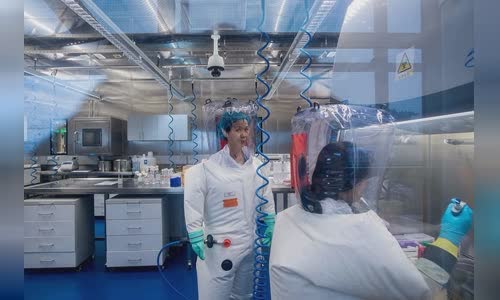Filling Tuan Hoa and Shenzhou, two Chinese bat research scientists, are noticed when the NCOV hypothesis leaks from the hot laboratory again.
In the video published by the National Scientific Agency and Chinese State Television CCTV on December 10, 2019, the researchers wear protective costumes from head to toe, climb the cliff in the cave,

Photo: AFP
We have to live a few days in the cave, fill in Tuan Hoa, one of the bat hunters, say in the video.
I can feel fears.
This is a modal window.
Beginning of Dialog Window.
End of Dialog Window.
Videos are then widely shared on social networks.
Video records his landscape and his team from the Centers for Disease Control and Prevention (CDC) Wuhan to catch horseshoe bats and Pipistrelle bats in the cave, while collecting samples to find new diseases from bats and
Videos are probably even more noticeable because of what it doesn't disclose.
According to the WHO report announced in March, Wuhan CDC rejected them any storage or laboratory related to the virus in the bat before the outbreak of Covid-19, the stance does not seem
There is no direct evidence that the relationship between the group's group or the disease expert on bat species at the Vu Han Virus Institute with Pandemic Covid-19.
Last week, US President Joe Biden directed US intelligence agencies trying to identify pandemic origins, including whether it was leaked from a laboratory accident.
Chinese officials have given WHO international experts to access limited information when they arrive in Wuhan to investigate the pandemic origin at the beginning of the year.
Chinese investigators - WHO announced the report in March, focusing on the hypothesis of viruses transmitted from animals to humans and saying that the hypothesis of the virus leaked from Wuhan Virus Institute is uncomfortable.
Another person was also noticed as the official Thach, the famous Corona virus researcher was dubbed the Chinese batwoman.
Her laboratory at the Wuhan Virus Institute discovered and studied NCOV's most recent known relatives, although scientists emphasize that decades need decades of natural evolution to these two viruses
Final Thach At Vu Han Virus Institute in 2017. Photo: AFP.
The WHO report said Ms. Thach told the international expert delegation that all fieldwork was carried out with a full protective equipment, including N95 masks, Tyvek's seamless clothes, goggles
In most cases, we wear a simpler protective suit, it's okay, she said and explained that most bat diseases could not infect humans directly to infect intermediate animals
In order to illustrate, she shows your heading scenes in the cave to catch bats and classify the sample later.
On February 2, 2020, after Covid-19 outbreaks, Thach published to Wechat that she brought her life to swear that her lab was not related to the pandemic.
When the questions about Wuhan Virus Institute are increasing, Thach writes a long statement for Science magazine in July, emphasizing that NCOV cannot come from Wuhan Virus, because of her team
However, she also acknowledged that the laboratory did not exercise the gene sequence of all patterns they have, because of financial and personnel restrictions.
Doubts about Wuhan Laboratory increased in January, after the US State Department said they had a reason to believe some researchers of Vu Han Virus Institute have symptoms similar to Covid-19.
Meanwhile, the laboratory of Wuhan CDC is less noticeable.
Filling is the Head of the Insect Control Parts of Wuhan CDC, but he is famous as an adventurer, passionate about discovering bats and insects.
He often went to places where others could not find to collect the patients needed, colleague Liu Jing said on local television in January 2020.
Using the net and traps, the group of filling has captured 155 bats in Hubei and hundreds of children in other regions in a study in 2013. He was a member of the group that discovered 1,445 new RNA viruses in animals
Wuhan CDC has held an internal meeting with the title of learning from the achievements of Dien Tuan Hoa.
Filling also acknowledges sometimes unsafe incidents.
On February 3, 2020, the group of fillers posted a preliminary clinical study of a NCOV-infected patient in Wuhan in Nature magazine, which only bats could be hostages.
Fill in quite quiet after NCOV spreads.
This highlights the challenge of independent investigations facing: Many people in Wuhan can hold important information that are silent, despite being pressured from officials or by personal choice.
Filling has continued its research while not appearing in public.



 Majaccount Khichi
Majaccount Khichi







